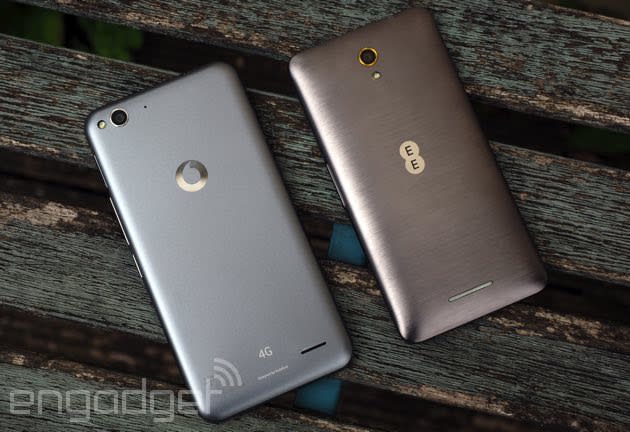Vodafone's Smart Ultra 6 is great value at £125

Own-brand devices appear to be all the rage at the moment, or at least for two of the UK's major carriers, they are. EE's recently launched new smartphones, a tablet and a 4G action cam, while Vodafone too is yielding a steady stream of bespoke handsets and slates. And now, just as EE's dipped its toe into the mid-range with its Harrier smartphone, Vodafone wades into the same waters with the Smart Ultra 6, its "most powerful" own-brander to date. Available from today, the mouthful of a phone is fronted by a 5.5-inch, 1080p display, with a 1.5GHz octa-core Snapdragon 615 humming away inside. For landscapes and selfies you've got 13- and 5-megapixel cameras, and in other key specs you're looking at 2GB of RAM, 16GB of expandable storage, a 3,000mAh battery and Android 5.0 Lollipop running the show. Not too shabby, considering the £125 pay-as-you-go price.
Vodafone's really stepped up its game since releasing its first own-brand 4G phones. Last year's Smart 4 Power, for example, was chunky and overpriced, whereas both the new Smart Ultra 6 and smaller Smart Prime 6 are more refined and attractively inexpensive. Now, the Ultra 6 isn't the prettiest handset I've ever come across, but it's not without its merits. The uniform, grey plastic that dominates the back and sides of the handset doesn't come off as cheap, and in fact looks well suited to the device. The placement of the main camera lens and companion flash give the rear panel an iPhone 6 vibe, to the Ultra 6's benefit, and the mirrored Vodafone logo fits nicely with the colour scheme. It's also better executed than the mirrored logos EE's coincidentally used on its latest phones. The blue glow emitted by the Android soft keys is also a nice visual touch, and is the calling card of Chinese manufacturer ZTE, which built the Ultra 6 for Vodafone using its own Blade S6 Plus handset as a reference point.

There's more to be said about the design of the Smart Ultra 6 than its visual attributes. It's a well-constructed, sturdy device, with a level of build quality that defies its bargain price. With microSD and nano-SIM trays tucked away on either side of the handset, there's no need for a removable back panel, which means there's one less seam to croak and warp under pressure. At 154 x 77 x 8.35mm, the Ultra 6 is a little big for my liking, and I find it slightly clumsy to use one-handed. It's not uncomfortable to wield in general, thanks to its relatively slim profile, and those wanting 5.5 inches of screen real estate won't feel like there's an excess of phone ballooning around the large display.
The Smart Ultra 6 runs Android 5.0 Lollipop, and while there's a handful of Vodafone bloatware apps pre-installed, you're getting more or less the stock experience. The only real differences from pure Android are the odd rogue app, like the camera, which usurps Google's version. The device's 1.5GHz octa-core Snapdragon 615 kicks out as much power as you realistically need. A few laps in Asphalt 8: Airborne and Real Racing 3 with no noticeable performance issues is testament to that, and in general usage, navigating the menus and jumping in and out of apps is just as fluid as on any Lollipop phone I've poked at.

Needless to say, the Smart Ultra 6 makes a good first impression, and at its price point, I can't think of another handset that offers the same kind of value for money. EE's Harrier, for example, is matched or bested by the Ultra 6 in every column on the spec sheet. And yet, the Harrier is £200 on pay-as-you-go, while the Ultra 6 is only £125. Vodafone will also give you a Smart Ultra 6 for free on contracts starting from £17. For comparison, the Harrier is free on contracts from £19 per month, and that plan includes double the amount of 4G data and minutes as Vodafone's £17 per month tariff. So, there's not much in it if you're taking the contract route, but it's hard to ignore the £75 discrepancy in pay-as-you-go pricing, especially when the Ultra 6 is better on paper in every area. With the Kestrel, EE showed Vodafone how affordable, own-brand phones should be done. This year, though, it's EE that has some catching up to do.














